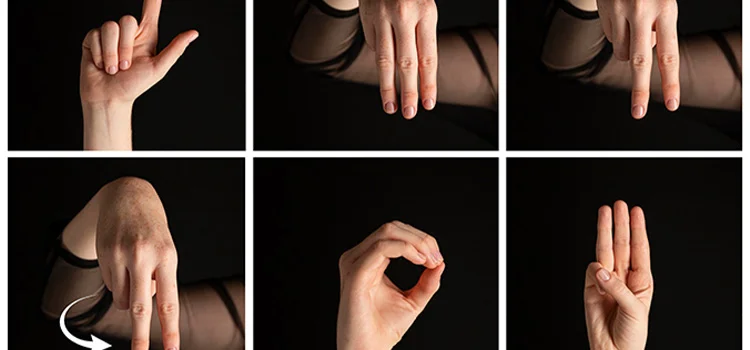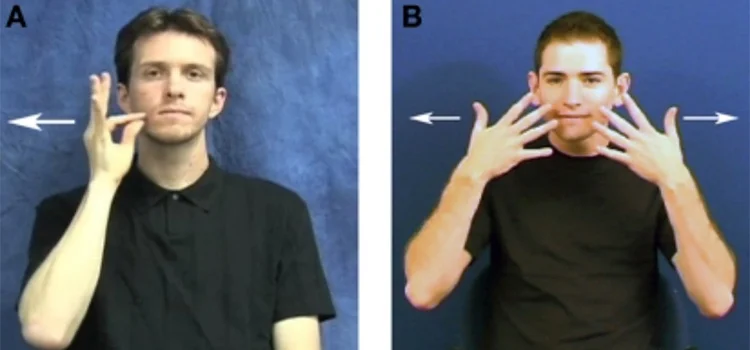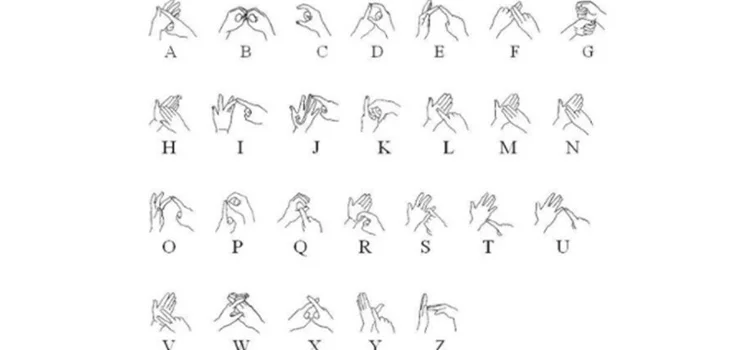BSL
What’s the Difference Between ASL and BSL?
ASL stands for American Sign Language and BSL stands for British Sign Language. It may seem that since both America and Great Britain share the same spoken language, their sign languages will share the same property. But that’s not the case. Both of these regions use completely different sign languages. So, what’s the difference between ASL and BSL?
Let’s take a deep dive into this topic.
But in case you’re not that familiar with these languages, let’s introduce them to you.
Table of Content
What is ASL?
ASL (American Sign Language) is a visual language primarily used by the Deaf community in the United States and parts of Canada. ASL has its own syntax and grammar rules.
Like any other natural language, ASL evolved with time and shared linguistic characteristics. This language is still evolving, stemming from the fact that it has variants of the language, which are regional dialects and accents of ASL. Age, race, topography, and sex all play a role in ASL differences, just as they do in spoken languages.
For example, Black American Sign Language (BASL) is a segregation-era version of ASL used by the Black Deaf community. New York Times has put together a beautiful article on BASL.
Currently, ten states in the United States recognise ASL as the official language of deaf people. These are:
- Alabama
- Colorado
- Georgia
- Indiana
- Maine
- Massachusetts
- Montana
- Oklahoma
- Rhode Island
- Utah
ASL is made up of a combination of:
- hand signals
- lip patterns
- facial expressions and
- body movements
What is BSL?
What sign language is used in the UK?
That’s British Sign Language or BSL.
BSL is the most widely used sign language in the United Kingdom. It was officially recognised as a language in 2003, but its usage dates back to the 1570s.
Usually, people who are deaf are its primary users. But those who have difficulty hearing or speaking use it to communicate too. In fact, if you go by the number of BSL users, you’ll understand how widespread the language is. According to the British Deaf Association or BDA, 151,000 people use BSL in the UK. 87,000 of these are deaf.
BSL is a dialect of BANZSL, which stands for British, Australian, and New Zealand Sign Language. While Australian Sign Language (Auslan) and New Zealand Sign Language (NZSL) are not the same as BSL, they share the same manual alphabet, grammar, and lexicons.
Just like ASL, BSL is also made up of a combination of:
- hand signals
- lip patterns
- facial expressions and
- body movements
How Many Sign Languages are There?
Are there different sign languages?
Yes, there are.
According to Sign Solutions, around 300 sign languages are currently in use worldwide. Here’s a list of them pulled from Wikipedia.
- With 20 million users, Chinese Sign Language (CSL or ZGS) sits at the top.
- Then comes Brazilian Sign Language, which has around 3 million users worldwide.
- In South Asia, over 1.8 million people use Indo-Pakistani Sign Language.
- Estimates tell us that there are between 250,000 to 500,000 people using ASL.
In the UK, BSL is the most widely used sign language, with around 151,000 users.
Which Sign Language is Universal?
At present, there is no universal sign language. Most countries have their own sign language, as you’ve seen in the case of ASL and BSL. In Europe, one of the most common search terms is “most common sign language in Europe”. But, as we’ve discussed, there is none.
However, it is worth noting that there is something called the “International Sign”. It’s a collection of internationally recognised signs used during international meetings of Deaf people from all over the world.
Examples of these events are:
- Deaflympics
- World Federation of the Deaf
- Mister and Miss Deaf World
It uses gestures, role-playing, and a large signing space to convey meaning. As International Sign borrows more from Western sign languages, it is also more understandable to Westerners than African and Asian Deaf people. But we have to understand that it’s not a full-fledged language to begin with.
Rather, it’s a sort of communication method that has been successfully used between signers who do not share the same sign language. It’s easier to grasp as it features a streamlined and highly iconic lexicon.
What’s the Difference Between ASL and BSL?
To understand the difference between ASL and BSL, we have to first understand what the basic structure of both of these sign languages look like.
Basic Structure of Sign Language
As the basic structure of both of these languages is the same, let’s take BSL, for example.
A sentence in English follows a traditional structure:
Subject + a verb + possibly an object
In the case of BSL, though, the language structure is as follows:
Topic- comment structure
The topic is stated first, and then a comment about that topic is said and subsequently explained.
Consider the following example for reference:
In English, we would say: The man is walking on the road.
But in BSL, we would say: Road man walk.
As the language is visual in its nature, you need to paint a mental picture of what you’re going to say before saying it and make sure that the other person can easily paint the same concept.
But, there are some rules. Have you noticed how, in the example above, the road comes before the man? It’s intentional. The most prominent object in the ‘painting’ or the ‘scene’ in your mind needs to be communicated first. Then gradually add the more minor elements. The action or the verb, in this case- walk, comes last. So that’s the basic structure of BSL.
Now for The Differences Between ASL & BSL
Vocabulary
ASL is used exclusively in the US. It shares roughly 30% of its signs with BSL. But even then, a user of ASL will be unable to understand BSL. Because, even though there is a significant overlap in the vocabulary, both of these languages are entirely unrelated.
Manual Alphabet
Another noticeable difference is the use of the one-handed manual alphabet in ASL and the two-handed manual alphabet in BSL.
Take this image, for example. See how the word ‘cat’ is signed in ASL versus BSL. The difference here is both the hand movements and the number of hands used to sign the word.
The vowels in BSL, for example, are made with your thumb and four fingers. The remainder of the alphabet is mostly done with two hands. The vowels and the rest of the alphabet in ASL, on the other hand, are written with one hand.
Take a look at the whole list of manual alphabets for both BSL and ASL here.
American Sign Language
British Sign Language
Dependency on Fingerspelling
Another significant distinction is that ASL users frequently use fingerspelling, whereas BSL users primarily use it for proper nouns such as names and places- when first stated.
So, rather than using fingerspelling, BSL users prefer to use classifiers to create new signs.
FAQs
Are BSL and ASL the same?
No, they aren’t. They are completely unrelated languages.
Which is better to learn BSL or ASL?
It depends on your geographical location. If you live in the US, ASL should be your choice. If you live in Great Britain, BSL is the choice for you.
Can BSL and ASL understand each other?
These two languages do share approximately 30% of the vocabulary. But unfortunately, users of these sign languages will still be unable to understand each other as they differ in so many ways.
Is ASL or BSL more useful?
No language is more or less useful. It depends on their users. If you live in England, obviously, ASL will be of no use for you since no one will understand you.
How is Black ASL different from ASL?
Black ASL or BASL is a dialect of ASL.
What’s the difference between ASL & BSL?
Some of the primary differences between ASL & BSL are
- Basic Structure of Sign Language
- Vocabulary
- Manual Alphabet
- Dependency on fingerspelling
What forms of sign language are used in the UK?
BSL and its regional accents are the most common sign languages in the UK. But some people also use Irish Sign Language (ISL). Sign Supported English (SSE), which is actually not a language, is also common.
Makaton is also utilised in conjunction with spoken language for those who might require help with communication or learning issues.
Does sign language differ between countries?
They do. Most countries have their own sign language.
Which sign language is universally understood?
There is currently no universal sign language. The majority of countries have their own sign language.
On-Demand Accredited Courses
Analyze data quickly and easily with powerful PHP library! All datasets included where beginners welcome!
Conclusion
Today, we’ve discussed the topic: what’s the difference between ASL and BSL? As you can see, they are completely different from each other despite being sign languages. Like any other natural spoken language, sign languages differ depending on who is using them. They evolve naturally like spoken languages and sometimes create regional dialects that may even look quite different.
If you want to learn BSL, Lead Academy has you covered. If you want a basic introduction to BSL, take a look at our Introduction to British Sign Language Course. However, if you want to dive a little deeper, you can do the British Sign Language Level 1 and 2 Online Course.
Although, if you want a qualification on BSL to become an interpreter, you’ll have to do an Ofqual accredited BSL Course. We have that too. Notice that this course will be more comprehensive than the previous courses as it will not just teach you how to communicate in BSL casually, but a lot more.
What to Read Next:
- Why is British Sign Language Important?
- British Sign Language Alphabet – BSL Fingerspelling with Images
- What is Fingerspelling
- How Long Does it Take to Learn Sign Language?
- Stupid in Sign Language – Video & Image Included
- Makaton Signs and Symbols – Image and Video Guide Included
- How to Learn BSL? Beginner to Advanced












